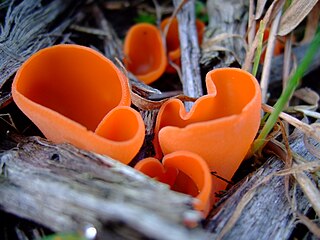
Pezizomycotina make up most of the Ascomycota fungi and include most lichenized fungi too. Pezizomycotina contains the filamentous ascomycetes and is a subdivision of the Ascomycota'. It is more or less synonymous with the older taxon Euascomycota. These fungi reproduce by fission rather than budding and this subdivision includes almost all the ascus fungi that have fruiting bodies visible to the naked eye.

Dothideomycetes is the largest and most diverse class of ascomycete fungi. It comprises 11 orders 90 families, 1,300 genera and over 19,000 known species. Wijayawardene et al. in 2020 added more orders to the class.

The Pleosporales is the largest order in the fungal class Dothideomycetes. By a 2008 estimate, it contained 23 families, 332 genera and more than 4700 species. The majority of species are saprobes on decaying plant material in fresh water, marine, or terrestrial environments, but several species are also associated with living plants as parasites, epiphytes or endophytes. The best studied species cause plant diseases on important agricultural crops e.g. Cochliobolus heterostrophus, causing southern corn leaf blight on maize, Phaeosphaeria nodorum causing glume blotch on wheat and Leptosphaeria maculans causing a stem canker on cabbage crops (Brassica). Some species of Pleosporales occur on animal dung, and a small number occur as lichens and rock-inhabiting fungi.

Dothideomycetidae is a subclass of Dothideomycetes consisting of three orders: Dothideales, Myriangiales and Capnodiales. The cavities of the sexual structures do not have vertical cells growing between the sac-like cells bearing the sexual spores (asci).

Pleosporomycetidae is a subclass of Dothideomycetes consisting of four orders: Pleosporales, Hysteriales, Mytilinidiales, and Jahnulales. One of its defining features is the presence of pseudoparaphyses. These are sterile cells extending down from the upper portion of the cavity inside sexual structures containing the sac-like asci with sexually produced spores (ascospores). Pseudoparaphyses are initially attached at both their ends, but sometimes the upper part may become free. Some orders and families where these cells are present remain outside the subclass since DNA based phylogenies cannot place them with confidence. However they could conceivably be included within Pleosporomycetidae in future.

The Botryosphaeriales are an order of sac fungi (Ascomycetes), placed under class Dothideomycetes. Some species are parasites, causing leaf spot, plant rot, die-back or cankers, but they can also be saprophytes or endophytes. They occur world-wide on many hosts. For example, in China, infections related to Botryosphaeriales have been recorded on numerous hosts such as grapes, Caragana arborescens,Cercis chinensis, Eucalyptus, Chinese hackberry, blueberry, forest trees, and various other woody hosts.

Arthoniomycetes are a class of ascomycete fungi. It includes two orders: Arthoniales and Lichenostigmatales. Most of the taxa in these orders are tropical and subtropical lichens.
The Lophiostomataceae are a family of fungi in the order Pleosporales. Taxa have a widespread distribution, especially in temperate regions, and are saprobic or necrotrophic on herbaceous and woody stems.
The Mytilinidiaceae are a family of fungi in the order Mytilinidiales. Taxa in the family are widely distributed, particularly in temperate zones, and are usually saprobic on woody tissue, especially gymnosperms.
Rosenscheldia is a genus of fungi in the class Dothideomycetes. The relationship of this taxon to other taxa within the class is unknown.
Cyrtidium is a genus of fungi in the class Dothideomycetes. The relationship of this taxon to other taxa within the class is unknown. Also, the placement of this genus within the Dothideomycetes is uncertain. A monotypic genus, it contains the single species Cyrtidium naevium.
Gloeodiscus is a genus of fungi in the class Dothideomycetes. The relationship of this taxon to other taxa within the class is unknown. Also, the placement of this genus within the Dothideomycetes is uncertain. A monotypic genus, it contains the single species Gloeodiscus nigrorufus.
Coccochorina is a genus of fungi in the class Dothideomycetes. The relationship of this taxon to other taxa within the class is unknown. Also, the placement of this genus within the Dothideomycetes is uncertain.
Pyrenochium is a genus of fungi in the class Dothideomycetes. The relationship of this taxon to other taxa within the class is unknown. Also, the placement of this genus within the Dothideomycetes is uncertain. A monotypic genus, it contains the single species Pyrenochium pini.
The Hysteriales are an order of fungi in the class Dothideomycetes, subclass Pleosporomycetidae. It consists of a single family, Hysteriaceae. Members of Hysteriales produce elongated, often boat shaped sexual structures with slit-like openings (hysterothecia). However species with these structures are very diverse. Comparisons based on DNA sequences indicate species with hysterothecia do not share a single ancestor and therefore species with hysterothecia can be found in several fungal orders. The newest definition of the order relies on DNA sequence differences and a combination of morphological characters.

The Trypetheliaceae are a family of mainly lichen-forming fungi in the order Trypetheliales. The family consists almost exclusively of corticolous (bark-dwelling), crustose lichens with an almost strictly tropical distribution.
The Myriangiaceae are a family of fungi in the Ascomycota, class Dothideomycetes. Species in this family have a widespread distribution, and are typically found associated with scale insects. The family occupies an isolated phylogenetic position within the Dothideomycetes.
The Davidiellaceae are a family of fungi in the Ascomycota, class Dothideomycetes. The family was defined in 2006 based on the results of molecular phylogenetic analysis of various Dothideomycetes species, and contains the genus Davidiella and six other genera.

The Gloniaceae are a family of fungi in the order Mytilinidiales.

Strigulales is an order of lichen-forming fungi in the class Dothideomycetes. It contains two families: Strigulaceae and Tenuitholiascaceae, with a combined total of 115 species. The order was proposed by Robert Lücking, Matthew Nelsen, and Kevin Hyde in 2013. Most species in the order are foliicolous, that is, they grow on plant leaves.










